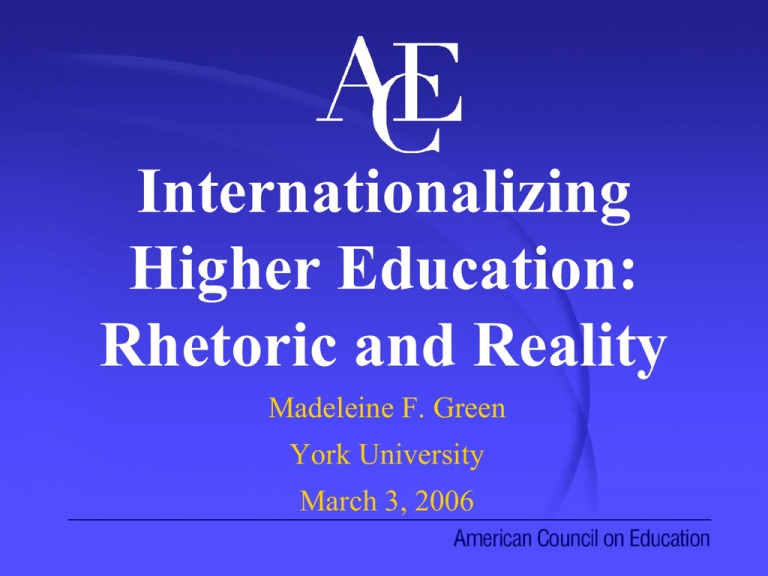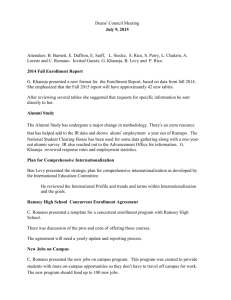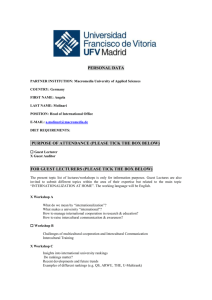International Education
advertisement

Internationalizing Higher Education: Rhetoric and Reality Madeleine F. Green York University March 3, 2006 Topics for Today • Watch your language: terms and definitions • The gap between dreams, aspirations, attitudes, and institutional practice • Making internationalization a reality Terms and Definitions Globalization • Flow of goods, ideas • Diminishing importance of boundaries of time and space • Diminishing importance of nation-state • Connections, interdependence • Often not a neutral term Definitions: Flows “…the closer integration of the countries and people of the world, which has been brought about by the enormous reduction in the costs of transportation and communication, and the breakdown of artificial barriers to the flows of goods, services, capital, knowledge, and (to a lesser extent) people across borders.” (Steiglitz, 2003) Definitions: Interdependence “...bringing all of humanity into a single ecosystem of embedded, overlapping networks. Borders, boundaries, delineations, and walls of any kind are slowly giving way to the compelling force of integration and interdependence.” (Garrison, 2004) Definitions: Neo-liberalism “We use the term globalization to represent neo-liberal economic ideology and its material strategies that aim to increase profits and power for transnational corporations, and similar strategies enabling government agencies to gain economic advantages and be competitive.” (Currie et al, 2003) Internationalization “The process of integrating an international, intercultural, or global dimension into the purpose, function, or delivery of postsecondary education.” (Knight 2003) Internationalization “...the complex of processes whose combined effect, whether planned or not, is to enhance the international dimension of the experience of higher education in universities and similar educational institutions.” (OECD) Internationalization • Is an ongoing process • Is intentional (if it is to have a lasting effect) • Affects the way we construct knowledge • Is systemic International Education Usually an aggregation of programs, activities: › International students › Study abroad › Courses › Co-curriculum › International cooperation Multicultural/Intercultural • In the U.S. context, multicultural is generally used to refer to domestic ethnic and racial diversity • Intercultural generally refers to the encounter between people of different nation-states or diaspora cultures • Overlap between two terms Issues • Is learning about/encountering another culture “at home” the same as doing so in a different linguistic and cultural context? • Points of synergy and tension between internationalization and multiculturalism Aspirations and Ambitions ACE Research • Public opinion surveys, 2000-2002 • studentPOLL data on high school • • • students, 2000 Status Report, 2000 Mapping Internationalization, 2003 Student attitudes and experiences in “high activity” institutions Student Interest in International Education Somewhat Interested Acquiring career-related experience 41 Courses on international issues at U.S. colleges 21 48 18 International student as roommate 55 International faculty at own U.S. college 55 Proficiency in another language 41 Internationally diverse student body 43 Gaining exposure to another culture 44 0% 10% 20% Very Interested 14 18 37 37 45 30% 40% 50% 60% 70% 80% 90% 100% ©Arts and Science Group International Experience of High School Seniors Percentage ©Arts and Science Group 100 90 80 70 60 50 40 30 20 10 0 98 52 27 12 Foreign Language in High School Speak Another Language at Home 10 Traveled Outside Traveled Outside the U.S. with the U.S. with Family School Participated in International Exchange Program Students Planning to Participate in International Courses and Programs 60 50 57 Percentage 50 40 48 30 28 20 10 0 Foreign Language Courses with an Course International Focus Study Abroad Internship Abroad Program ©Arts and Science Group Faculty Attitudes • 67% agreed that it is the responsibility of ALL faculty to provide undergraduates with an awareness of other countries and cultures • 64% agreed that most undergraduate students graduate with this awareness Public Support for International Education Percentage 2000 100 90 80 70 60 50 40 30 20 10 0 71 74 Foreign Languages 2002 77 77 International Courses 75 79 Study Abroad 85 80 International Students ACE 2001 Survey: Dimensions of Internationalization • • • • • • • Articulated commitment Academic requirements Organizational structure Funding Communication structure Faculty opportunities Student opportunities Institutional Commitment to International Education Yes No 35 Mission Statement 64 28 Strategic Plan 69 49 Task Force 51 34 Formal Assessment 66 4 Tenure Policy 0 96 10 20 30 40 50 60 Percentage (%) 70 80 90 100 International Course Requirements • 41% of institutions have an international course • • requirement Of those with a requirement, over 60% require one course, 21% require two courses, and 19% require three or more courses Of those with a requirement, 62% require students to take a course that primarily features perspectives, issues, or events from nonwestern countries or areas Supporting Structures • 23% have no office • 49% have no full-time non-student support staff where there is one office • 55% have no full-time non-student support staff where there are multiple offices External Funding for International Education Federal 20% No Funding 43% Other 6% State 10% Private 34% Developing an Internationalization Strategy Multiple Rationales for Internationalization • Academic excellence • Job preparation • Global citizenship • Competition and positioning • Institutional revenue Two Complementary Strategies • Institutional goals and strategies (inputs) • Student learning goals and outcomes (outputs/outcomes) Elements of Internationalization (inputs) • • • • • • • • Campus culture Academic opportunities Co-curriculum International partnerships Funding Supporting structures and policies International Students Synergy among the elements Challenges • Internationalization is marginal • International programs, activities are • • • • • fragmented Emphasis on inputs not outcomes Faculty interest and capacity Reward system Study abroad is a major strategy, but not the only one Lack of institutional strategy Using a Student Learning Outcomes Approach Why Articulate Student Learning Goals? • Presents an opportunity for a shift away from an ad • • • • hoc approach to internationalization Offers a “guiding star” approach to align curriculum with desired outcomes Can help others to understand impact Good educational practice -- outcomes/assessment offers a road map for improvement Quality control -- accrediting agencies mandate The Fundamental Questions about Student Learning • What do we want our students to know? To be able to do? What attitudes are we trying to foster? • Where would students at our institutions actually acquire these knowledge, skills, attitudes? (mapping exercise) Fundamental Questions (cont’d) • What is our evidence that students are achieving these outcomes? (assessment) Challenges of Developing and Assessing Outcomes • Difficulty of agreeing on outcomes • Coordinating levels: institution, • • college, department We still don’t have a culture of assessment in higher education Assessment is too infrequently looped back into improvement Challenges (continued) • Faculty workload issues • How to integrate—use “regular” student work as artifacts for assessment But There are Rewards… • Closing the gap between rhetoric and reality • Quality improvement • Students can articulate their learning for themselves and others Reviewing Internationalization Strategies and Activities Getting There • Catalog the state of campus • • • • internationalization Clarify goals (institutional and student learning goals) Identify challenges/obstacles Develop or revise internationalization plan Assign responsibility and monitor progress The Process • Develop a leadership team › Size › Legitimacy › Leadership • Set a schedule • Plan communications and involvement Elements of the Review • • • • • • • • Articulated commitment Academic offerings and requirements Student opportunities Faculty opportunities Funding Communication structure Supporting structures and policies Campus culture Framing a New Conversation on Internationalization • Create multiple campus conversations • Create conversations in the disciplines • Benefit from outsiders and their ideas • Use cross-departmental work-groups • Create supporting structures What is the Outcome? • Map what is going on • Identify gaps • Identify possibilities for synergy • Develop a plan based on solid • information The process is also the product—create a campus conversation Conclusion • Comprehensiveness • Integration • Intentionality • Leadership




